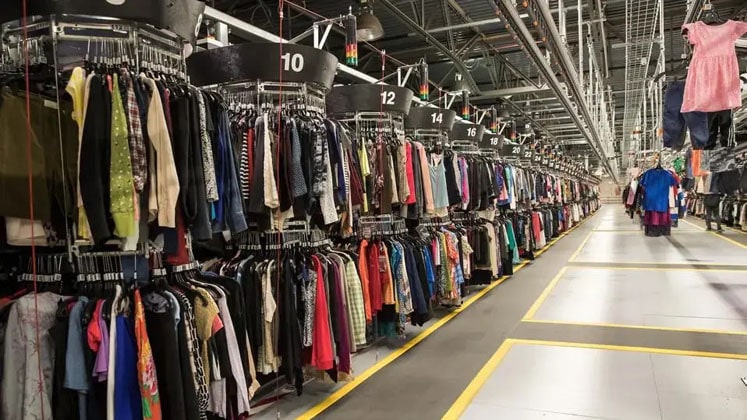FW
Ellaassay, a top women’s wear brand from China has chosen Lectra Fashion PLM to support its brand management and global business strategy. Lectra, the world leader in integrated technology solutions is dedicated to industries using soft materials like fabrics, leather, technical textiles and composite materials.
Ellasassay creates elegant, haute couture, developed using sophisticated fabric and apparel technologies. The company insists on a very high level of product quality therefore it invests heavily in technology as well as in international design talent. The company’s goal is to grow into a Chinese fashion brand that influences both the domestic and international stage. They are the first Chinese haute couture brand to participate in New York Fashion week, presenting at the event’s main venue.
Ellaassay designs and develops 80 per cent products in-house and manufactures their entire range themselves. Lectra Fashion PLM will help it improve collaboration between its design, development and production teams. With Lectra’s Fashion Platform, each department will be able to work with the same information in real-time. Lectra Fashion PLM will also help the company better control workflow and collection planning. By allowing Ellassay to manage the entire fashion development process with a comprehensive solution, Lectra Fashion PLM will help the company optimize costs.
www.ellassay.com/en/main.htm
www.lectra.com
The garment industry in Cambodia is largest foreign currency earner for the country. It reported a 20 per cent rise in exports last year, according to the figures of the Ministry of Commerce. The Southeast Asian nation exported apparel products worth 5.53 billion dollars, up by 20 per cent from 4.61 billion dollars a year earlier.
Garment products have been mostly sold to the United States and European countries, and some Asian countries, particularly Japan, China, and South Korea.Last year, apparel exports to the United States went up by 7.6 per cent, to Europe rose by 28 per cent, and to other countries increased by 32 per cent.
The garment and shoe industry accounts for about 80 per cent of the country's total exports. The sector comprises more than 900 factories with about 600,000 workers. The whole industry had closed for two weeks in late December and early January due to protests to demand the wage pay hike. All factories reopened on January 6 after the government issued a temporary ban on all forms of demonstrations following two violent clashes on January 2 and 3 that resulted in death of four protesters.
www.moc.gov.kh
The International Home Textiles and Furnishings Fair will be held at the Hong Kong Convention and Exhibition Centre from April 20 to 23, 2014. Over 220 exhibitors from six countries and regions like China, India, Czech Republic and Taiwan are expected to attend. The show will highlight exhibits that focus on sustainable, recyclable, reusable materials and products, especially to fulfill the needs of hotel chain buyers.
There will be a number of themes catering to key market segments. Design Solutions and Trade Services will feature interior designers and branding experts who will give buyers advice on material sourcing as well as design solutions, branding and in-store environment ideas. It will be a one-stop sourcing platform for home textile buyers.
The ‘Hall of Glamour’ will feature trendy and branded home furnishing and household textile products, covering towels, bedding, curtains and carpets. The ‘Window Fashion & Accessories’ zone will give buyers a wide range of choices in woven and readymade curtains, blinds and accessories for functional and decorative purposes. Other zones include: Baby & Bedroom Textiles, Bathroom & Kitchen Textiles, Carpet & Floor Coverings and Upholstery & Furnishing Products.
Simultaneously the Hong Kong Houseware Fair, will showcase a comprehensive spectrum of household-related products and textiles for easy and one-stop sourcing.
www.hktdc.com/fair/hkhometextilesfair.../HKTDC-Hong-Kong-Internati...
Sutlej Textiles and Industries recorded a net profit of Rs 111 crores during the nine months of the current financial year as against Rs 61 crores during the corresponding period last year, a growth of 82 per cent. Revenues grew by 12 per cent during this period. EBITDA showed a growth of 36 per cent.
Sutlej is a manufacturer of value added synthetic, cotton and blended yarns, fabrics and home furnishing. Its production facilities are vertically integrated, from spinning and weaving to dyeing and finishing. The company is expanding spinning its capacity and upgrading existing projects. The strategy is to focus on manufacturing niche products in the yarn category namely specialty and value added yarns.
Innovative R & D enables it to broaden its sourcing capabilities, strengthening its ability to mitigate volatile raw material prices over the years. The company hopes the implementation of capacity addition and modernization will further consolidate its position within the industry and enable it to deliver a healthy financial performance going forward.
Sutlej Textiles has won several export awards. It has a footprint in countries like Australia, Argentina, Bangladesh, China, Turkey, United States and UAE.
sutlejtextiles.com/
Even though Bangladesh, India, Pakistan and Sri Lanka compete against each other in the global market on various textile products, each country produces certain products in which it has an edge over others. The four major textile players of the subcontinent can join hands to chalk out a strategy to facilitate others in the textile value chain. They can liberalise trade at least in those textile value chain items that they import from outside the region and reduce their costs.
This could improve the competitiveness of the region. Since textile is a labor intensive sector, better management of the value chain would boost productivity in all countries and create more jobs. There are a number of textile value chain products that could lower the costs of each country if barriers to trade in those specific items are removed.
Pakistan enjoys an advantage in home textiles, India has an edge in blended textiles and Bangladesh and Sri Lanka have expertise in clothing. Pakistan could import apparel accessories from India, India could avail of the idle processing capacities in Pakistan, Sri Lanka could get custom made fabrics from India and Pakistan and Bangladesh could become a top supplier of skilled labor force for the apparel sector.
Du Pont’s innovative Surlyn product range promises to be a source of creative new ideas for designers and brands in the perfume and cosmetics industry. This is a 3D textile technology that involves the over moulding of a container wrapped in textile with Surlyn resin. This encapsulation technology with Surlyn allows objects, images, design elements and now even textiles to look as suspended in a crystal-clear cap for quite astonishing visual effects. The over moulded decorations maintain fine details and show no distortion. So the design is preserved and magnified, such as the delicate red poppy embedded in the new cap of the recently launched Kenzo flower in the Air perfume.
Inside Kenzo’s cap produced with DuPont Surlyn by the French packaging company SAF is encapsulated a poppy corolla, visible from both sides, thanks to a special laying and over moulding process developed by SAF.
DuPont Surlyn resins are available in a wide variety of proven grades designed for specific packaging needs. With Surlyn brands can reduce the number of leaking packages, increase line speeds, shut out contaminants, increase efficiency, and handle the toughest of packaging challenges. The resin has sparkling clarity, high gloss, critical handling advantages, and is puncture resistant.
www2.dupont.com/Surlyn/en_US/
Being organised for the first time in Shanghai, Intertextile Shanghai Apparel Fabrics – Spring Edition 2014 will showcase the latest apparel fabrics and accessories, as well as new trends for the industry. To be hosted from March 3 to 5, 2014 at the Shanghai World Expo Exhibition and Convention Center, over 1,000 exhibitors from 19 countries and regions will display their latest products spread over 55,000 sq. mtr. of exhibition space. Visitors can also view the Intertextile Directions Trend Forum and Fabrics China Trend Forum.
The Intertextile Directions Trend Committee has been put together by industry experts from New York, Milan, Paris and Tokyo who have developed four themes to illustrate the Spring/Summer 2015 trends. The four themes are: Breathe, Play, Dance and Dive.
To understand more about domestic trends, buyers can visit the Fabrics China Trend Forum developed by China Textile Information Centre, where the latest suiting and ladies wear fabric trends will be showcased through the use of exhibitors’ fabrics under four themes: Smart City, Aesthetic Fantasy, Midnight Palace and Fascinating Tribe.
A new DNA-based technology has been developed that can help a company identify the textile raw material as well as finished products. SigNature T is a DNA-based security platform. Fibers, yarn, fabric, garments and labels can be marked with unique, secure and enduring SigNature DNA that can be definitively authenticated at any point in the supply chain.
The new binding and extraction technique enables a cost-effective, flexible and robust anti-counterfeiting and anti-diversion protection for textiles and apparel including military protective wear. Manufacturers armed with SigNature T markers will have a flexible, forensic, impenetrable product authentication tool, protecting textiles from fiber to hanger. High quality fibers, including merino wool, Extra Long Staple cotton, cashmere, silk, and even high performance polyester fibers, can be marked at the original point of manufacture, prior to baling. The SigNature T DNA application requires no change to the existing production process, and can be controlled so that each bale or batch can be marked and tracked throughout the supply chain.
Hundreds of millions of kilograms of fiber can be marked using a single DNA marker, offering strong adhesion to the fiber, and providing a means to authenticate anywhere along the supply chain from fiber to the finished product; from distributor to retailer to consumer.
South African clothes manufacturers are witnessing a rise in demand for locally manufactured merchandise, as fast fashion has made in-roads into the country. The industry is also on a growth track after receiving government incentives. Local manufacturers have got a boost and the entire supply chain since domestic production is not just good for job creation but it has also led to retailers sourcing almost a third of their clothing from local suppliers.
According to experts, 25 to 30 per cent of locally sold clothes are manufactured domestically. Edcon, for instance, has increased local and regional orders to cash in on the benefits of a quick response. For 2013 winter season, Edcon sourced 32 per cent of Edgars and discount merchandise from local and regional suppliers. The Foschini Group was one of the first major retailers to begin sourcing locally.
In 2009 the government had introduced incentives to meet the criteria and rules of the system, allowed it to offer conditional grant finance to increase competitiveness in the sector and encourage clustering. Industry players are working with RMG manufacturers, textile companies and the unions to see if further tweaking of the incentives could achieve a lower cost of inputs.
There’s good news for apparel exporters in Bangladesh. Foreign buyers are beginning to return. At one time, buyers had stopped coming to the country because of factory fires, collapsing buildings, workers' unrest over wages, and political violence.
But the government’s export-friendly initiatives are wooing back buyers and new orders are trickling in. The government’s new policies include: five per cent cash assistance in export through TT, reduction of interest rate of Export Development Fund, rescheduling of default loans without any down payment or based on the relationship between the bank and the client, and advance payment in importing industrial goods. The garment market is again showing signs of revival with workers' discontent over wages coming to an end. The EU has said it has no plans to revoke GSP facilities. However problems of gas and power supply and creaky infrastructure persist.
The Bangladesh government has also prepared a draft of rules to implement labor laws. There is international pressure to amend laws and put them in place to improve and ensure workplace safety and labor standards. One proposal is that a garment manufacturer needs to have a hospital on the premises. The labor ministry has been requested to formulate business-friendly rules.












